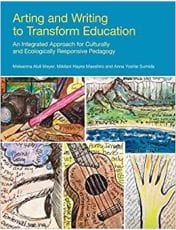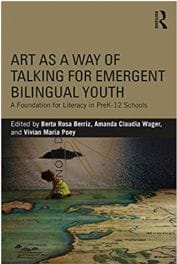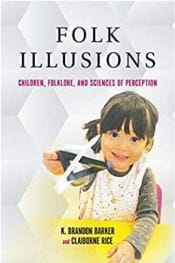
Arting and Writing to Transform Education: An Integrated Approach for Culturally and Ecologically Responsive Pedagogy, by Meleanna Aluli Meyer, Mikilani Hayes Maeshiro, and Anna Yoshie Sumida
(Sheffield, U.K.: Equinox Publishing Ltd. 2018, vii + 261, forward, editor’s preface, acknowledgments, references, appendices, list of contributors, index.)
Winona Wynn is Associate Professor of Humanities; Indigenous Studies/Ethnic Literature Coordinator; Andrew W. Mellon Undergraduate Fellowship; Yakima Nation Tribal Court Advocate (CASA), and Yakima Nation Cultural Museum, Education and Outreach at Heritage University.
Three Indigenous women, through a Native Hawaiian worldview (Kanaka Maoli), encourage us to reframe our everyday teaching interactions as radical acts of inclusion. They effectively call us into critical circles of relational constructs through their inspiring text, Arting and Writing to Transform Education: An Integrated Approach for Culturally and Ecologically Responsive Pedagogy. This narrative, from which emerges the neologism, arting, encourages the reader to consider this new concept as an inextricable, contextual connection to the act of writing. For additional conceptual support, the overall text includes 215 visual representations: graphics, photos, paintings/drawings, and charts, as well as nine Appendices offering representative, interdisciplinary classwork templates. The theme of arting and writing is effectively woven throughout the text and is the foundational catalyst for dialogue and calls to action in three distinct sections.
Part I, “New Ideas of Transformation and Culture,” begins by encouraging us to reconnect with the Freirian premise that inclusion of the political, economic, historical, cultural, ecological, and social issues of real life sustains the power to “…deconstruct stereotypes, awaken intellectual strengths, and work toward social justice for the greater good” (p. 18). Furthering this proposition, the authors suggest that a situated and empowered sense of self can be achieved when arting and writing essentially centers on the local ecology and primary culture of students.
Part II, “Arting and Writing in Parallel: Catalysts for Transformation,” offers an Indigenous perspective on creativity, which iterates the energy-producing and organic nature of all things. This section focuses on the origin of arting and presents it as parallel to the process of writing, which includes an aspect of visual thinking, and is “a kind of knowing, from an intuitive sensorial orientation” (p. 54). Additionally, the Four Realms of Culture, illustrated in this section as “nesting baskets,” are introduced as a backdrop and foreground for engaging students as they employ the arting-and-writing process as a tool for interpreting their world. The first realm, the home culture is where identity is formed, shaped, and validated. It is the starting place where familial, ancestral, and ecological relationships begin to interconnect. Next is the Host/Indigenous Culture, the notion of homeland, which can be a contested space. The third realm, the local, involves the everyday, the familiar spaces that Freire would consider opportunities for both observation (understanding our own relational subject position) and transformation (deepening those understandings and their impact. Finally, the global realm positions everyone as a contributor to our humanity. Overall, Part II is infused with clear and adaptive tutorials on how to implement projects. This section culminates in a subsection titled, Exhibiting and Publishing: Nurturing the Writer, which speaks to a mentoring journey, getting a student to the point of pride in their work and their story.
Part III, “Arting and Writing in Practice: Illustrative Teaching Material,” begins with Active Seeing: Relationships to all Living Things. This unit gracefully incorporates the elements of the Indigenous worldview into the arting-and-writing process by offering teaching units and lessons that take into account background knowledge, objectives, arting-and-writing activities, materials, and supporting illustrations, for example, clear photos of leaves for identification in the natural environment.
This powerful and generous final section challenges the real and perceived boundaries between elementary and higher education spaces. This text written primarily for elementary teachers has crossed that boundary by employing an Indigenous approach to learning, clearly presenting the interrelated path that brings knowledges together. The authors discuss moving through the process of “arting” and equivocate that newly introduced verb to the act of writing. They discuss the interplay between writing and arting and identify it as a dynamic interface through which these two processes weave a convergence beyond their individual benefits to create a compelling and holistic learning experience. This focus places this entire text into the category of “critical and ongoing resource,” for all educators who desire a collaborative, place-based, community-responsive approach to their teaching.
 Art as a Way of Talking for Emergent Bilingual Youth: A Foundation for Literacy in PreK-12 Schools, by Berta Rosa Berriz, Amanda Claudia Wager, and Vivian Maria Poey, eds.
Art as a Way of Talking for Emergent Bilingual Youth: A Foundation for Literacy in PreK-12 Schools, by Berta Rosa Berriz, Amanda Claudia Wager, and Vivian Maria Poey, eds.
(New York: Routledge. 2018, 275 pp.)
Elena Foulis is Coordinator of Service-Learning and Heritage Learning at The Ohio State University.
Art as a Way of Talking for Emergent Bilingual Youth centers on the idea that students, in particular those who are multilingual and from multicultural backgrounds, do not arrive to the classroom with an empty slate. Each project described in this important collection builds on students’ funds of knowledge to create collaborative art projects that honor students’ cultural and social capital. There are three sections, each focusing on a specific art form and all centered on using culturally relevant pedagogy that nurtures students’ self-confidence about who they are and their linguistic journeys. Chapter after chapter, we are presented with an example and a project that teachers have creatively designed to build equity among all learners, in particular, our emergent bilingual youth. Although I find each chapter pushing us to think about the value of building spaces in our classrooms and, just as crucially, inviting family to engage in the learning process, I was particularly interested in thinking of our students as linguistics geniuses, as Alfaro and Bartolomé refer to our emergent bilingual youth in Chapter 3. They define a linguistics genius as “a communicatively competent student who can discern their audience speaking ability and use of language(s) and spontaneously employ their own linguistic and creative repertoire to receive, process, communicate and deliver information” (46). Indeed, whether students engage in original writing, digital art, video production, drawing, photography, hip hop, drama, poetry, or graphic novels, when they are encouraged to bring their lived experiences into their creative productions, they are empowered and educators recognize the knowledge they already possess as they are learning a new language. In doing so, hierarchies that make English the language of success are broken down.
This collection of essays walks us through projects that educators and practitioners have created with the students and community in mind, in particular communities who are often marginalized and go to school in districts with limited funding. One key example of pushing to continue to incorporate the arts into the lives of students is the family art backpack project in Chapter 5. The project was a response to budget cuts, but it showed the commitment of educators, students, and families to continue to make art a central part of academic growth. It is worth noting that each project presented offers an opportunity to develop creative thinkers who work in teams to analyze different media. This is most explored in the chapters of Section III that describe how students engage in social activism through drama, storytelling as a way to revitalize Indigenous languages, and critical multi-literacies via the graphic novel.
In a time when arts education is often the first program to be eliminated in our public schools because of funding, teachers can use evidence-based approaches to continue to integrate the arts as a vital element for students’ social-emotional growth and their development as bilingual and multilingual learners. Even more, each chapter offers resources such as a list of books for each project, websites, and other references to support educators who might want to use a similar design. In addition, each section ends with a “questions for reflection and further application for practice” unit that provides further insight into how to integrate these ideas into our classrooms. This is a wonderful resource for the K-12 classroom, and it can be especially useful to those who teach courses for Heritage Language Learners at the university level, given that students have historically not been asked to share their lived experiences in the classroom as a source of knowledge. As an educator, this book offers me several examples of how to decolonize my classroom linguistically and culturally, whether in K-12 schools or at the university.
 Folk Illusions: Children, Folklore, and Sciences of Perception, by K. Brandon Barker and Claiborne Rice
Folk Illusions: Children, Folklore, and Sciences of Perception, by K. Brandon Barker and Claiborne Rice
(Bloomington: Indiana University Press. 2019, xvi +244 pp.)
Lisa Gabbert is Associate Professor of Folklore and American Studies at Utah State University.
This well-informed, highly theoretical book by K. Brandon Barker and Claiborne Rice is an excellent contribution to the field of folklore that breaks new ground. An important contribution of the book is the identification, classification, and analysis of a heretofore unrecognized folklore genre, usually performed by children, that the authors call “folk illusions.” Folk illusions are defined as “traditionalized verbal and/or kinesthetic actions performed in order to effect an intended perceptual illusion for one or more participants” (04). The first chapter is spent arguing for the existence of this genre and outlining its salient features, while other chapters discuss aspects such as transmission, variation, the effect of performance on perception, and relations between perception, embodiment, and belief. The authors primarily are interested in overlaps between embodiment, awareness of perceptual processes, and culture, and their main argument is that embodiment and perceptual processes are always already enculturated and that perception is active, shared, and culturally influenced. They use different kinds of folk illusions as evidence to support these points.
Folk illusions have not been attended to in folklore studies (my own guess is they likely have been included more generally under “games” or “tricks” by children’s folklorists, if at all), so the authors are to be commended for carving out this bodily genre with specificity. Barker and Rice approach their subject interdisciplinarily, drawing from a variety of fields that deal with perception and the body—including the cognitive and behavioral sciences and experimental psychology—as well as phenomenology and philosophy. These disciplines have attended to the perceptual dimensions of illusions and are helpful for identifying embodied processes, but, as the authors note, there is no research that examines perceptual illusions in the context of situated cultural traditions, and non-folklore studies tend to ignore or trivialize the discursive aspects, which are quite important to some illusions like “Light as a Feather” that include an extended narrative. Folklorists have long been interested in children’s folklore for what it may reveal about developmental and cognitive processes as well as learning, and this book can be situated within that vein of scholarship.
In addition to being well grounded theoretically, the book also has a number of practical aspects such as the appendix, which is entitled a “Catalog of Folk Illusions” and is a typology. Type A, “Haptic Illusions,” consists of multiple sub-types, including A1 “Crossed Fingers,” which is then further divided into A1A, “Crossed Fingers, Split Tongue” and A1B “Double Crossed Fingers.” A2 is “Where Am I Touching You?,” and A3 is “The Chills,” each of which is discussed in the book and further classified into additional divisions. The catalog ends with the letter J, “Taste Illusions,” and, like other typologies, has the capacity to be expanded. There are also online audiovisual materials available, consisting of videos of children engaging in and performing folk illusions, which is useful as it can be difficult to follow the written descriptions. There is not a video of every folk illusion in the classification guide, but there are videos for many. There are also several indices, including an index of subjects and an index of illusions.
This is not a child-centered book, meaning that it does not unpack what folk illusions mean to children or provide a children’s emic perspective. This is not a criticism, but merely a statement of fact. One critique, however, is that the concept of play is given short shrift in the discussion and analysis. Given that play by definition entails the creation of an alternative reality, and that this also seems to be a purpose of folk illusions, a more thorough theorization of play in relation to the performance of folk illusions might have shed further light on the processes and nature of the genre. This criticism is quite minor, however, since, as noted above, the book is very highly informed and informative.
The audience for this book is primarily university researchers, particularly those interested in overlaps between folklore and cognitive science and/or phenomenology, and scholars interested in the ways in which perception and embodiment more broadly are enculturated. Children’s folklorists also will find it of interest, as well as those teaching university graduate classes. It is not geared toward K-12 educators or those working in the public sector. In this very thorough book, the authors have moved the field forward by forging further links between folklore and the cognitive sciences, illustrating quite concretely how the gaps in those disciplines can be served by the field of folklore.
 Handbook for Folklore and Ethnomusicology Fieldwork, by Lisa Gilman and John Fenn
Handbook for Folklore and Ethnomusicology Fieldwork, by Lisa Gilman and John Fenn
(Bloomington: Indiana University Press. 2019, 248pp.)
Jordan Laney is a research consultant, writer, and instructor for Virginia Tech, where she completed her PhD in Social and Cultural Theory.
From those engaging with folklore for the first time to experienced researchers, Lisa Gilman and John Fenn’s Handbook for Folklore and Ethnomusicology Fieldwork serves as a clear guide to the ethnographic process. Unique in its attention to both folklore and ethnomusicology’s methodological concerns, the Handbook is clearly organized by reflecting the process of being “in the field” while thinking of challenges and questions from an educator’s point of view. The Handbook reflects the research process by organizing content into three sections: preparation, immersive fieldwork, and project analysis and completion. This organizational schema allows practitioners and educators to address challenges often overlooked in qualitative study and introduces different methods within context. The authors consistently define and limit the scope to participatory and observational ethnographic fieldwork, encouraging readers to engage with interactive research practices.
Just as the text encourages engaged research practices, it offers resources for an engaged classroom. Uniquely, weaving questions of research ethics with helpful “how to” guides and formulaic examples for conducting research, the Handbook urges readers to question why particular methods are chosen and the impact that methods have on research. Chapters often present content and conclude with exercises and tips. For example, Chapter 5, “Documenting and Technology,” offers extensive options for documentation and fieldwork equipment or gear. It includes reasons for using one over the other and examples (63-74). The chapter concludes with tips for technology. Many exercises throughout include follow-up reflection questions for students. Educators will find supplemental activities beyond the examples and premade activities on the press website, accessible with purchase of the book.
Similarly, the authors make it clear that “fieldworkers affect what happens in a research situation” and urge students to take power relations in the field seriously (138). This explicit call to recognize power within methodology can be a heavy topic. While issues of social and cultural power have been widely discussed in ethnomusicology and folklore, teaching texts and practical lessons designed to engage in transformative pedagogy are few. The Handbook delves into theoretical discussions of knowledge production as well as ethical issues. Drug use, coding, and relationships that arise throughout the fieldwork process are a few of the carefully explored topics. Data, discussion questions, and scenario examples are provided, equipping those entering the field with tools to navigate ethically almost all anticipated situations. While this level of discussion would be specifically helpful for higher education settings, much of the content could be successfully adapted for middle and high school classrooms.
Perhaps most importantly, the authors address the work to be done after returning from the field. How to organize, identify, protect, and share data can be frustrating in practice and elusive to teach, but Gilman and Fenn create a clear path for the reader. Particularly helpful are sections on managing data with attention to the ethics of coding, analysis, and representation (199). Handouts, clear examples of data logging and organization, and common transcription practices are provided, as well as important conversations about interpretive authority and translation. While there is not an appendix for educational activities and handouts, appropriate scenarios leading to discussion questions and group or individual exercises are featured in each chapter as ready-made lessons.
Above all, Gilman and Fenn pull from different sources to gather and synthesize best practices for the researcher or educator in one highly organized book. A strength of the Handbook is its incredible adaptability with a broad intended audience, making the Handbook for Folklore and Ethnomusicology Fieldwork a promising textbook for introductory college courses and practitioners alike. From helpful tips on data collection to personal introductions and gaining consent, one cannot overstate the usefulness of this text in the classroom or the field.
